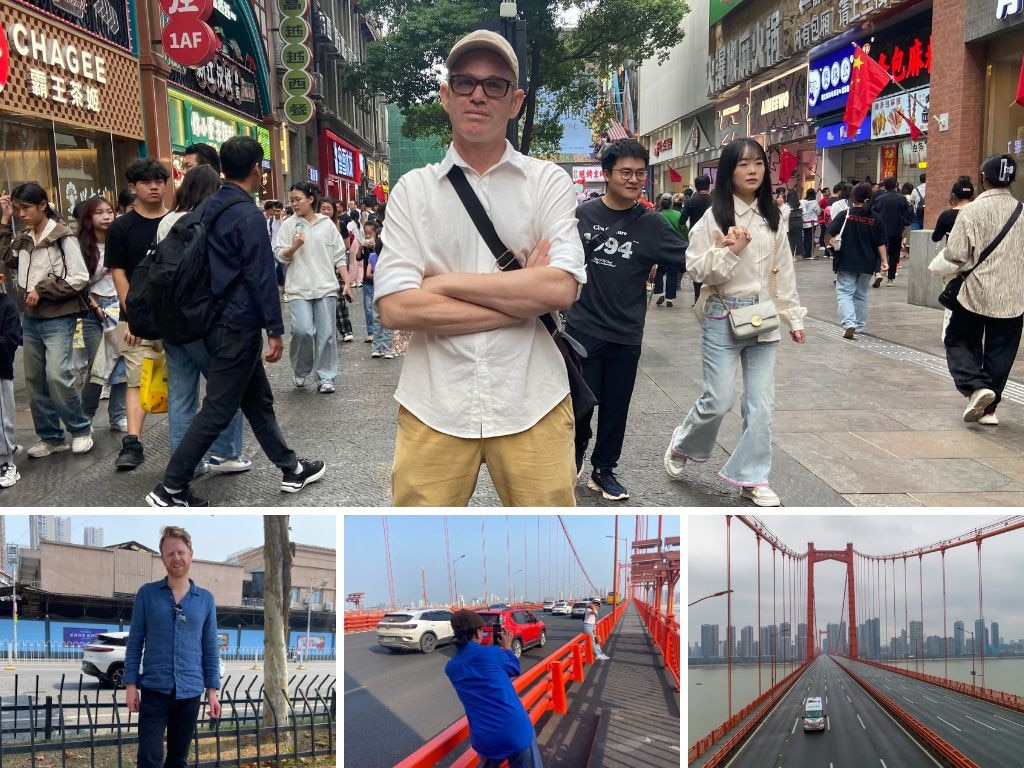Wuhan goes viral again as the ‘robotaxi capital of the world’
The Chinese metropolis is again commanding international attention – this time as the unlikely rival to San Francisco in the race to roll out self-driving cars. The Australian takes a ride in one to see what all the fuss is about.

The Chinese city of Wuhan is again commanding international attention – this time as the unlikely rival to San Francisco in the race to become the “robotaxi capital of the world”.
Tesla billionaire Elon Musk took to a Hollywood movie set this month to spruik his vision of a world of driverless cars. In Wuhan that future arrived in 2022.
Chinese tech giant Baidu now has more than 400 fully self-driving Apollo Go cars taking passengers – including, on a recent trip to Wuhan, The Australian – around a city with a population of almost 11 million, the size of Sydney and Melbourne combined.
Right now, they are allowed to drive on almost half of the enormous city’s roads.
Baidu plans to ramp up its self-driving fleet in Wuhan to 1000 by the end of the year – which makes it by far the biggest in the world. It would have done so earlier this year if Wuhan’s taxi drivers hadn’t freaked out the city government with a protest.
“Wuhan is famous for its uprisings. The government is worried the taxi drivers will rise up,” a source familiar with the Wuhan government’s thinking told The Australian.
Many close observers think with a bit of compensation – and the threat of a stick or two if those carrots don’t work – Wuhan’s ambitious government will soon get the robotaxi rollout back on its world-leading course.
It’s one of the key planks in the central Chinese city’s plan to become a “world-class hub for technological innovation”, part of a national tech uplift being championed by President Xi Jinping.

Seemingly every month another Chinese city announces plans to add a robotaxi fleet. Baidu alone is already operating in more than 10 cities in China. Chinese self-driving rivals Pony.ai and WeRide are also expanding.
On an earnings call in late August, Baidu’s billionaire CEO Robin Li tried to temper fears about the pace of the rollout, which has raised concerns about a mass lay-off of taxi drivers in a slowing economy that is struggling to create new jobs.
Baidu’s Apollo Go fleet is now taking about 290,000 rides a month, but that still accounts for just 1 per cent of the ride-hailing market in Wuhan. “It will take many years for us to reach a meaningful market share in China or elsewhere,” Li said.
But the rise of the robots is on the minds of many in China. A real estate agent from Xi’an said he had always thought, if business selling property got any worse, he could switch to driving a Didi or one of China’s other Uber-like ride hailing businesses to pay the bills. “Now what can I do?” he said.

Many others welcome the change. China’s taxi drivers don’t have the best reputations. The trip from Wuhan’s main railway station to my hotel in an old-school taxi was by far the scariest trip I took in the city. With frightening detachment, the driver watched videos on his smartphone as he hooned across the sprawling metropolis. By contrast, my two trips in Baidu’s fifth generation Apollo Go robotaxis were master classes of diligent driving.
One trip was through early evening rush hour traffic, giving the Apollo Go white sedan plenty of opportunity to get into trouble and cause chaos. A hard U-turn under a busy overpass was a formative experience early in the trip, but the car’s sensors judged everything perfectly.
Later on, a van suddenly cut across our path. Robo slammed the brakes with the reflexes of a Formula 1 champion before a chorus of honking from surrounding traffic shamed the human driver.
After more than a decade of development and testing, Baidu, Pony.ai and WeRide say their robotaxis are around 10 times less likely to get into an accident than a human driver. They are also significantly cheaper, as they try to lure in customers into their sensor-and-camera-laden sedans.

Wuhan is full of converts. Many wish the rollout would happen faster.
One person who works for the city’s government said his elderly mother had started using a robotaxi for her weekly grocery shop. He used to have to take her to the store in his car – neither of them trusted the city’s taxi drivers with the trip.
When it is possible, he wants to buy a self-driving car for his mother, which he says will be able to earn some side income by working as a robotaxi for the majority of the week when his mother won’t be using it.
“With a robotaxi, I will be free and she will be free,” he said, smiling at the vision of this fast-approaching future.
These are some of the benefits – the increased safety, the more efficient use of vehicles, the related drop in urban space used by carparks – that Musk sketched in his recent product launch.
For now, Tesla doesn’t have any “Cybercabs” operating. Musk says the company will start taking customers in 2025, if approvals come through.
For now the only serious rival to the Baidu fleet in Wuhan is run by the Google spin-off Waymo, which has a similar-sized 400-odd fleet in San Francisco.

Billions of dollars have been spent on developing the technology and now Waymo’s co-chief executive, Tekedra Mawakana, is sounding bullish. “We’ve been at this for a long time – 15 years in the rearview mirror – and we’ve hit this point of acceleration,” she recently told The Wall Street Journal.
This month, Uber chief executive Dara Khosrowshahi said he expected that within a decade half of the rides booked on his platform would be for self-driving cars. Uber has partnered with Waymo and WeRide.
There are no driverless cars that Australians can flag right now. Evidently, that’s going to change in the near future.
In Canberra, Infrastructure, Transport, Regional Development and Local Government minister Catherine King’s department is working on an “Automated Vehicle Safety Law”, in partnership with state and territory governments, ahead of the arrival of robotaxis, robotrucks and more on Australian roads.
“The Australian government recognises automated vehicles have many potential benefits, including improved road safety, mobility and accessibility. However, they could also bring new safety and security risks, which is why governments are working together on new laws to regulate these vehicles,” an Australian government spokeswoman said.
As well as revolutionising how people will travel, it looks set to be another front in the battle between China and America for the technological heights of the new economy.
The Albanese government has said that it has no intention of following America’s lead in banning Chinese EV software or mimicking the EU’s new Chinese EV tariffs. But self-driving cars instructed by Beijing will raise blood pressure among Australia’s national security community.

Whether made in China or America, many Australians will take some convincing that all of this is a good idea.
While most of the millions of rides by self-driving cars have gone smoothly, there have been some shockers. General Motors’ self-driving operation Cruise had its licence to operate in California suspended after one of its vehicles dragged a pedestrian pushed into its path by a human hit-and-run driver.
In Wuhan, many call the Baidu fleet “dumb robots” after a series of mishaps that have gone viral on the Chinese internet.
A taxi driver in the city relished retelling them as he drove me to a part of Wuhan where I could hail one of his driverless competitors.
There was, he recalled, the driverless car that caused a traffic jam after stopping in front of an empty plastic bag. And the time two driverless vehicles approached each other and stopped – neither apparently having the wit to go around the other.
And, most damaging for Baidu, the video of one of its white Apollo Go driverless cars hitting a scooter. The company has since explained that the accident was caused by the scooter driver running a red light.
“I wouldn’t dare give my life to a robot,” the taxi driver told The Australian.
That said, he was frank that his profession is on the endangered species list. By 2030, he thinks his human driving skills will be redundant in China. “By then, I will have to retire,” he said, matter of factly.








To join the conversation, please log in. Don't have an account? Register
Join the conversation, you are commenting as Logout